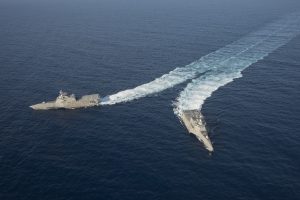The Pentagon announced its proposed 2022 budget last week, which must ultimately be approved, and is likely to be modified by, Congress. Concern over China’s growing fleet and missile arsenal has fueled calls to build a larger navy, requiring a much bigger shipbuilding budget. But the new plan calls for fewer ships than many expected, and proposes accelerated cuts to parts of the existing fleet that U.S. Navy leaders believe have limited utility against a potential Chinese threat.
The Pentagon’s statement said that the new budget “addresses strategic competition with China through calculated defense investments,” especially for the navy and air force. Paying for those particular new investments means that more traditional programs and systems now face cuts.
The navy’s most recent shipbuilding plan was released in the waning months of the Trump administration, and included a path to reach the 355-ship fleet that former President Donald Trump repeatedly promised, but never budgeted for, by the early 2030s. That plan projected purchasing 12 ships in the 2022 budget, including two destroyers, one of a new class of frigate, a large-deck amphibious ship, two attack submarines, and a variety of support vessels.
The 2022 navy budget unveiled at the Pentagon proposes eight ships – it keeps both planned attack submarines, the new frigate, and several auxiliary support vessels, but cuts one destroyer and the large-deck amphibious ship (which is functionally a light aircraft carrier that can launch F-35B fighter jets).
It also maintains funding for the Columbia-class ballistic missile submarine program, the sea-based leg of the United States’ nuclear deterrent, accounting for nearly a fifth of the navy’s overall shipbuilding budget even though the first boat will not commission for nearly a decade. The navy is rushing to complete the new submarines to replace its aging Ohio-class missile submarines, which will begin to be retired in 2029.
In addition to the smaller-than-expected shipbuilding plan, the budget also cuts more than a billion dollars-worth of ships, including seven Aegis cruisers, the four oldest Freedom-class littoral combat ships (which have been plagued by maintenance problems and still lack a clear mission), and an older amphibious ship, meaning that instead of growing, the U.S. fleet could shrink by three ships.
The U.S. Navy has sought to retire some of its older cruisers for years. These vessels serve an important air-defense mission and are a key part of carrier strike groups, but their maintenance demands are growing larger and less predictable. Congress has consistently pushed back against those retirement plans, but the cost of modernizing and extending the lifespan of those ships has ballooned and navy leaders are concerned that the investment would yield limited additional operational value and potentially cut into funds to procure a newer air defense ship later in the decade. For now, the navy intends for an upgraded version of the venerable Arleigh Burke-class destroyers to take over that air defense role starting in 2025 until a replacement for the cruiser is designed and purchased closer to 2030.
Admiral Ron Boxall, who directs force structure and resource assessments for the Joint Staff, told reporters that the budget divests older, legacy systems to prioritize new, more advanced capabilities. “Without divestments, we cannot afford to modernize to the evolving threat environment,” he said.
In the navy budget, those modernization priorities include nearly doubling the budget for “conventional prompt strike,” which is the navy’s hypersonic weapons program. The navy plans to accelerate its deployment of hypersonic weapons, putting them on the three Zumwalt-class destroyers in 2025 and then newer Virginia-class submarines in 2028. Alongside U.S. Army plans to deploy a land-based hypersonic weapon in 2023, these long-range missiles that fly at more than five times the speed of sound are seen as a key deterrent against China’s growing naval fleet and array of missiles capable of targeting ships and bases across the Western Pacific.
The budget also increases funds for the SM-6 missile, which can perform air and missile defense and can be used against surface ships, and for the marines’ land-based anti-ship missile program. The new mobile anti-ship missile launchers are a part of the U.S. Marine Corps’ new littoral strategy. From expeditionary bases established in contested archipelagic environments like the South China Sea, the missiles would allow the marines to support the navy against adversary fleets. Key to establishing and supporting those bases was supposed to be a new light amphibious warship, but that too was cut from the new shipbuilding budget.
































